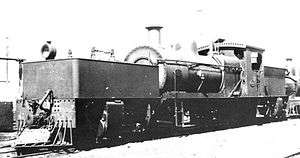WAGR Msa class
WAGR Msa class|

Works photo of Msa468, taken in 1930. |
|
|
|
|
|
|
|
|
The WAGR Msa class was a class of 2-6-0+0-6-2 Garratt-type articulated steam locomotives. The class was built at the Midland Railway Workshops and operated by the Western Australian Government Railways (WAGR) between 1930 and 1963. It was the first Garatt type to be designed and constructed entirely in Australia.
History
The class was preceded on the WAGR system by the M/Ms class Garratts. The class were used extensively on WAGR lines with light rails and sharp curves, as a consequence many of the smaller older branch lines on the Darling Scarp; as well as those with steep inclines such as those on the Mundaring Weir, Nannup, and Flinders Bay lines. In their later years, the boiler pressure was reduced to match that of the M/Ms class. By this stage they had been concentrated on the Bunbury to Boyup Brook and Pinjarra to Boddington lines.[1][2][3]
Hearsay evidence suggests that the poor quality of the boilers in the Msa rendered some inoperable by the late 1940s. The last remaining Msa was awaiting moving to a preservation status in the adjacent to the Midland Railway Workshops, when instructions were misunderstood by a scrap metal company employee, and it was cut up.
Class list
The numbers and periods in service of each member of the Msa class were as follows:
Builder's
number |
First
number |
Second
number |
In service |
Renumbered |
Withdrawn |
Notes |
|---|
| 46 |
466 |
491 |
000000001930-02-22-000022 February 1930 |
000000001947-09-22-000022 September 1947 |
000000001963-10-07-00007 October 1963 |
Stowed 3 April 1962 |
| 47 |
467 |
492 |
000000001930-02-22-000022 February 1930 |
000000001949-11-16-000016 November 1949 |
000000001963-10-07-00007 October 1963 |
|
| 48 |
468 |
493 |
000000001930-04-26-000026 April 1930 |
000000001948-07-29-000029 July 1948 |
000000001963-10-07-00007 October 1963 |
Stowed 20 September 1961 |
| 49 |
469 |
494 |
000000001930-05-31-000031 May 1930 |
000000001947-11-01-00001 November 1947 |
000000001963-10-07-00007 October 1963 |
Stowed 8 November 1961 |
| 50 |
470 |
495 |
000000001930-06-28-000028 June 1930 |
000000001947-10-02-00002 October 1947 |
000000001963-10-07-00007 October 1963 |
|
| 51 |
471 |
496 |
000000001930-07-19-000019 July 1930 |
000000001947-10-01-00001 October 1947 |
000000001963-10-07-00007 October 1963 |
Stowed 27 September 1959 |
| 52 |
472 |
497 |
000000001930-08-16-000016 August 1930 |
000000001947-07-11-000011 July 1947 |
000000001963-10-07-00007 October 1963 |
Stowed 29 June 1961 |
| 53 |
473 |
498 |
000000001930-09-13-000013 September 1930 |
000000001948-06-03-00003 June 1948 |
000000001962-09-06-00006 September 1962 |
Stowed 20 January 1962 |
| 54 |
474 |
499 |
000000001930-10-04-00004 October 1930 |
000000001948-04-30-000030 April 1948 |
000000001963-10-07-00007 October 1963 |
Stowed 12 August 1960 |
| 55 |
475 |
500 |
000000001930-11-01-00001 November 1930 |
000000001948-02-06-00006 February 1948 |
000000001963-10-07-00007 October 1963 |
Stowed 14 December 1958 |
|
|
See also
References
Notes
- ↑ Watson, Lindsay (1995). The Railway History of Midland Junction: Commemorating The Centenary Of Midland Junction, 1895-1995. L&S Drafting. ISBN 0 646 24461 2.
- ↑ Turner, Jim (1997). Australian Steam Locomotives 1896-1958. Kenthurst: Kangaroo Press. p. 107. ISBN 086417778X.
- ↑ Oberg, Leon (2010). Locomotives of Australia 1850s-2010. Dural: Rosenberg Publishing. pp. 208–209. ISBN 9781921719011.
Bibliography
- Durrant, A E (1981). Garratt Locomotives of the World (rev. and enl. ed.). Newton Abbot, Devon, UK; North Pomfret, Vt, USA: David & Charles. ISBN 0715376411.
- Gunzburg, Adrian (1984). A History of WAGR Steam Locomotives. Perth: Australian Railway Historical Society (Western Australian Division). ISBN 0959969039.
External links
 Media related to WAGR Msa class at Wikimedia Commons
Media related to WAGR Msa class at Wikimedia Commons
![]() Media related to WAGR Msa class at Wikimedia Commons
Media related to WAGR Msa class at Wikimedia Commons

